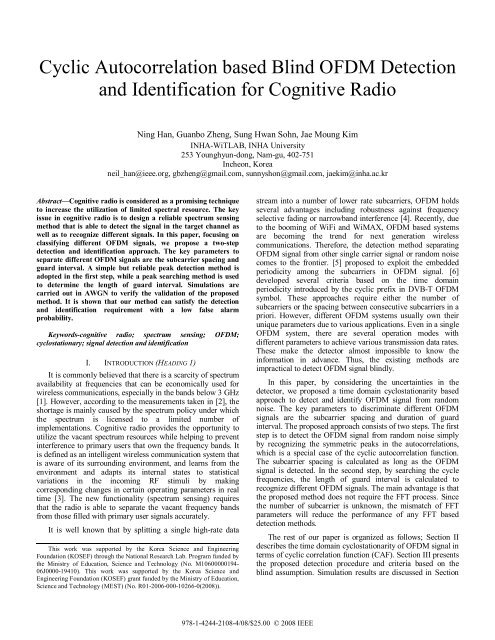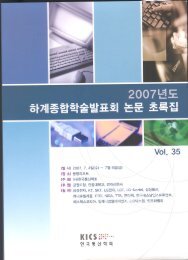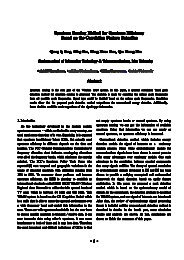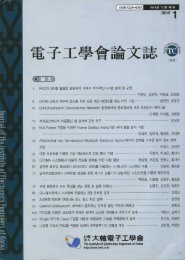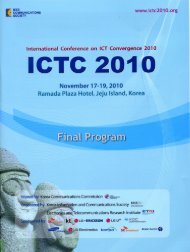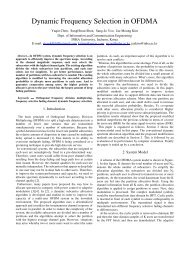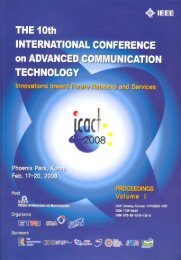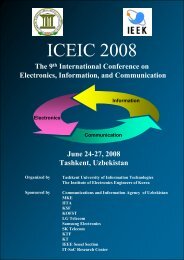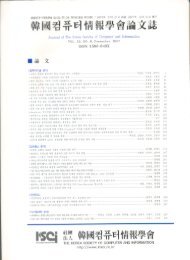Cyclic Autocorrelation based Blind OFDM Detection and ...
Cyclic Autocorrelation based Blind OFDM Detection and ...
Cyclic Autocorrelation based Blind OFDM Detection and ...
Create successful ePaper yourself
Turn your PDF publications into a flip-book with our unique Google optimized e-Paper software.
<strong>Cyclic</strong> <strong>Autocorrelation</strong> <strong>based</strong> <strong>Blind</strong> <strong>OFDM</strong> <strong>Detection</strong><br />
<strong>and</strong> Identification for Cognitive Radio<br />
Ning Han, Guanbo Zheng, Sung Hwan Sohn, Jae Moung Kim<br />
INHA-WiTLAB, INHA University<br />
253 Younghyun-dong, Nam-gu, 402-751<br />
Incheon, Korea<br />
neil_han@ieee.org, gbzheng@gmail.com, sunnyshon@gmail.com, jaekim@inha.ac.kr<br />
Abstract—Cognitive radio is considered as a promising technique<br />
to increase the utilization of limited spectral resource. The key<br />
issue in cognitive radio is to design a reliable spectrum sensing<br />
method that is able to detect the signal in the target channel as<br />
well as to recognize different signals. In this paper, focusing on<br />
classifying different <strong>OFDM</strong> signals, we propose a two-step<br />
detection <strong>and</strong> identification approach. The key parameters to<br />
separate different <strong>OFDM</strong> signals are the subcarrier spacing <strong>and</strong><br />
guard interval. A simple but reliable peak detection method is<br />
adopted in the first step, while a peak searching method is used<br />
to determine the length of guard interval. Simulations are<br />
carried out in AWGN to verify the validation of the proposed<br />
method. It is shown that our method can satisfy the detection<br />
<strong>and</strong> identification requirement with a low false alarm<br />
probability.<br />
Keywords-cognitive radio; spectrum sensing; <strong>OFDM</strong>;<br />
cyclostationary; signal detection <strong>and</strong> identification<br />
I. INTRODUCTION (HEADING 1)<br />
It is commonly believed that there is a scarcity of spectrum<br />
availability at frequencies that can be economically used for<br />
wireless communications, especially in the b<strong>and</strong>s below 3 GHz<br />
[1]. However, according to the measurements taken in [2], the<br />
shortage is mainly caused by the spectrum policy under which<br />
the spectrum is licensed to a limited number of<br />
implementations. Cognitive radio provides the opportunity to<br />
utilize the vacant spectrum resources while helping to prevent<br />
interference to primary users that own the frequency b<strong>and</strong>s. It<br />
is defined as an intelligent wireless communication system that<br />
is aware of its surrounding environment, <strong>and</strong> learns from the<br />
environment <strong>and</strong> adapts its internal states to statistical<br />
variations in the incoming RF stimuli by making<br />
corresponding changes in certain operating parameters in real<br />
time [3]. The new functionality (spectrum sensing) requires<br />
that the radio is able to separate the vacant frequency b<strong>and</strong>s<br />
from those filled with primary user signals accurately.<br />
It is well known that by splitting a single high-rate data<br />
This work was supported by the Korea Science <strong>and</strong> Engineering<br />
Foundation (KOSEF) through the National Research Lab. Program funded by<br />
the Ministry of Education, Science <strong>and</strong> Technology (No. M10600000194-<br />
06J0000-19410). This work was supported by the Korea Science <strong>and</strong><br />
Engineering Foundation (KOSEF) grant funded by the Ministry of Education,<br />
Science <strong>and</strong> Technology (MEST) (No. R01-2006-000-10266-0(2008)).<br />
978-1-4244-2108-4/08/$25.00 © 2008 IEEE<br />
stream into a number of lower rate subcarriers, <strong>OFDM</strong> holds<br />
several advantages including robustness against frequency<br />
selective fading or narrowb<strong>and</strong> interference [4]. Recently, due<br />
to the booming of WiFi <strong>and</strong> WiMAX, <strong>OFDM</strong> <strong>based</strong> systems<br />
are becoming the trend for next generation wireless<br />
communications. Therefore, the detection method separating<br />
<strong>OFDM</strong> signal from other single carrier signal or r<strong>and</strong>om noise<br />
comes to the frontier. [5] proposed to exploit the embedded<br />
periodicity among the subcarriers in <strong>OFDM</strong> signal. [6]<br />
developed several criteria <strong>based</strong> on the time domain<br />
periodicity introduced by the cyclic prefix in DVB-T <strong>OFDM</strong><br />
symbol. These approaches require either the number of<br />
subcarriers or the spacing between consecutive subcarriers in a<br />
priori. However, different <strong>OFDM</strong> systems usually own their<br />
unique parameters due to various applications. Even in a single<br />
<strong>OFDM</strong> system, there are several operation modes with<br />
different parameters to achieve various transmission data rates.<br />
These make the detector almost impossible to know the<br />
information in advance. Thus, the existing methods are<br />
impractical to detect <strong>OFDM</strong> signal blindly.<br />
In this paper, by considering the uncertainties in the<br />
detector, we proposed a time domain cyclostationarity <strong>based</strong><br />
approach to detect <strong>and</strong> identify <strong>OFDM</strong> signal from r<strong>and</strong>om<br />
noise. The key parameters to discriminate different <strong>OFDM</strong><br />
signals are the subcarrier spacing <strong>and</strong> duration of guard<br />
interval. The proposed approach consists of two steps. The first<br />
step is to detect the <strong>OFDM</strong> signal from r<strong>and</strong>om noise simply<br />
by recognizing the symmetric peaks in the autocorrelations,<br />
which is a special case of the cyclic autocorrelation function.<br />
The subcarrier spacing is calculated as long as the <strong>OFDM</strong><br />
signal is detected. In the second step, by searching the cycle<br />
frequencies, the length of guard interval is calculated to<br />
recognize different <strong>OFDM</strong> signals. The main advantage is that<br />
the proposed method does not require the FFT process. Since<br />
the number of subcarrier is unknown, the mismatch of FFT<br />
parameters will reduce the performance of any FFT <strong>based</strong><br />
detection methods.<br />
The rest of our paper is organized as follows; Section II<br />
describes the time domain cyclostationarity of <strong>OFDM</strong> signal in<br />
terms of cyclic correlation function (CAF). Section III presents<br />
the proposed detection procedure <strong>and</strong> criteria <strong>based</strong> on the<br />
blind assumption. Simulation results are discussed in Section


